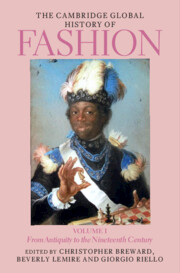Book contents
- The Cambridge Global History of Fashion
- The Cambridge Global History of Fashion
- The Cambridge Global History of Fashion
- Copyright page
- Contents for Volume I
- Figures for Volume I
- Maps for Volume I
- Table for Volume I
- Contributors for Volume I
- Preface
- 1 Global History in the History of Fashion
- Part I Multiple Origins of Fashion
- Part II Early Modern Global Entanglements
- 7 Magnificence at the Royal Courts in the Islamic World
- 8 Early Modern Fashion Cities
- 9 Fashioning Possibilities
- 10 Fashion Beyond Clothing
- 11 Fashion and the Maritime Empires
- 12 Garments of Servitude, Fabrics of Freedom
- Part III Many Worlds of Fashion
- Index
- References
7 - Magnificence at the Royal Courts in the Islamic World
from Part II - Early Modern Global Entanglements
Published online by Cambridge University Press: 04 August 2023
- The Cambridge Global History of Fashion
- The Cambridge Global History of Fashion
- The Cambridge Global History of Fashion
- Copyright page
- Contents for Volume I
- Figures for Volume I
- Maps for Volume I
- Table for Volume I
- Contributors for Volume I
- Preface
- 1 Global History in the History of Fashion
- Part I Multiple Origins of Fashion
- Part II Early Modern Global Entanglements
- 7 Magnificence at the Royal Courts in the Islamic World
- 8 Early Modern Fashion Cities
- 9 Fashioning Possibilities
- 10 Fashion Beyond Clothing
- 11 Fashion and the Maritime Empires
- 12 Garments of Servitude, Fabrics of Freedom
- Part III Many Worlds of Fashion
- Index
- References
Summary
The Ottoman, Safavid, and Mughal empires are the focus of this chapter, which between them covered a stretch of Eurasia between Budapest and Murshidabad in Bengal (India). Royal magnificence is the lens through which I will assess the fashion dynamics of these imperial dynasties. The Ottoman realm included Southeastern Europe, with the capital city of Istanbul straddling the border between Europe and Asia. From 1516 to 1517, Egypt, Iraq, and Syria – in the broad and historical sense of the latter term – were part of the territory controlled by the sultans as well. Apart from the brief timespans during which the Safavids held Iraq, their realm corresponded roughly to present-day Iran and sections of Afghanistan. Other regions that today are part of Afghanistan, including Kabul, were part of the Mughal Empire, which had expanded first over the territories covered by today’s Pakistan and northern India. In the second half of the sixteenth century, moreover, Emperor Akbar (r. 1556–1605) added the highly productive territories of Bengal and Gujarat to his realm. About a hundred years later, Aurangzeb (r.
- Type
- Chapter
- Information
- The Cambridge Global History of FashionFrom Antiquity to the Nineteenth Century, pp. 193 - 230Publisher: Cambridge University PressPrint publication year: 2023



